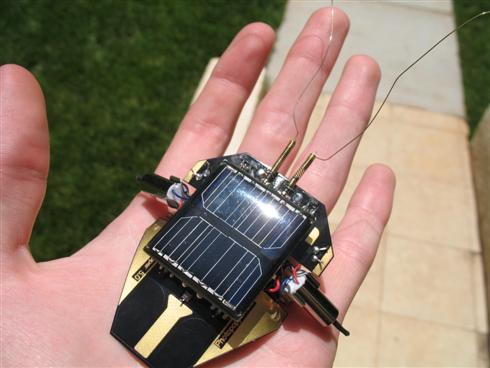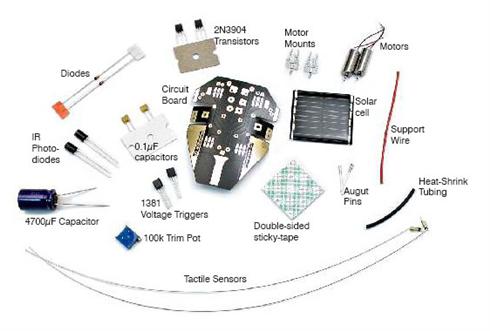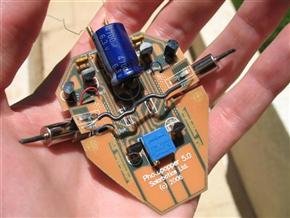By Evan Ackerman

I like robots rather a lot, but I never thought I might actually be capable of building one until I ran across a website about photovore robots. Most photovores are small, solar powered BEAM (biologically inspired) bots with a solar panel, light sensors, and a tiny motor or two. In the same way that herbivores eat herbs and carnivores eat carnies, photovores ‘eat’ photons in that their light sensors tell their motors to chase bright light to ‘feed’ their solar panel. I decided to try to build one myself, and bought a small kit from Solarbotics.com.
Full review after the jump.

 The kit I chose (the Photopopper 5.0) wasn’t the simplest, in that it involved a fair amount of soldering, which I’d never done before. But it looked cool, kinda like a cockroach, and what better excuse to learn how to solder than building a bugbot? I went out and got myself a soldering iron for something like 7 bucks at RadioShack, and when the kit arrived less than a week later, I went to work. The included manual was one of the best assembly guides I’ve ever used for anything, and once I got the soldering technique down (which took perhaps 5 minutes), I had my photovore assembled at the end of an easy (and fun) afternoon.
The kit I chose (the Photopopper 5.0) wasn’t the simplest, in that it involved a fair amount of soldering, which I’d never done before. But it looked cool, kinda like a cockroach, and what better excuse to learn how to solder than building a bugbot? I went out and got myself a soldering iron for something like 7 bucks at RadioShack, and when the kit arrived less than a week later, I went to work. The included manual was one of the best assembly guides I’ve ever used for anything, and once I got the soldering technique down (which took perhaps 5 minutes), I had my photovore assembled at the end of an easy (and fun) afternoon.
I took this video at around 1pm, which is close to solar noon here in northern California. My little bot is heading more or less south towards the sun, but since it’s pretty close to over his head, he sometimes decides to go in circles. Although his movements are controlled by extremely simple logic (move motor on opposite side to brightest light, or motor on same side as antenna contact), what with reflected light sources and both real and false antenna contacts, he manages to develop quite a personality. His movements certainly look more biological than robotic, and it’s not too much of a step to say that insects may have the same sort of “programming” effecting them.
The total cost of the kit was $50, including shipping, which seems like a great deal. The soldering iron I bought was another $7. The manual was superb, with lots of illustrations, and the bot was easy to adjust and seems quite rugged. He does need a fair amount of light to move… He zips along under bright sunlight, but doesn’t much like being indoors and can’t feed off of fluorescent light. He’s supposed to last 10-15 years, and if I let him, he’d happily wander around outside the whole time. The whole daytime, anyway, or until the cat decides he’s just too weird and takes action.





He’s a cute little guy. 🙂
I just built a small solar panel onto my roof wich had a wire running down to a smal fan that I clipped onto my cap. Summer gaming! Would be cool if I could buy one of those kits and modify it so that the solar panel would swivel in the suns direction.
Very cute! But I am such a clutz with small things, though – I took one look at all the pieces and it’s way out of my league. That’s not even including the “learn to solder” bit!
Don’t worry! I know how you feel. There’s plenty of instructions for easier robots that don’t use such small parts. Some are battery powered, but can later be modified for solar operation. Here’s a couple of my favorites:
http://home.wanadoo.nl/m.m.avos/others.htm
http://costaricabeam.solarbotics.net/Circuits/Vores_Main.htm
These can give you a great deal of practice. Plus, they won’t cost nearly as much.
If you need more help, you can email me, and I’ll give you some more links. Please note the it’ll take me a while to reply (week or two). I don’t check that email account much, but I will respond eventually.
Dustin
At last…
*
Thank you!
breast augmentation atlanta breast augmentation philadelphia
interesting thank you…
breastreduction beforeafter breast denver reduction
v
v
s
s